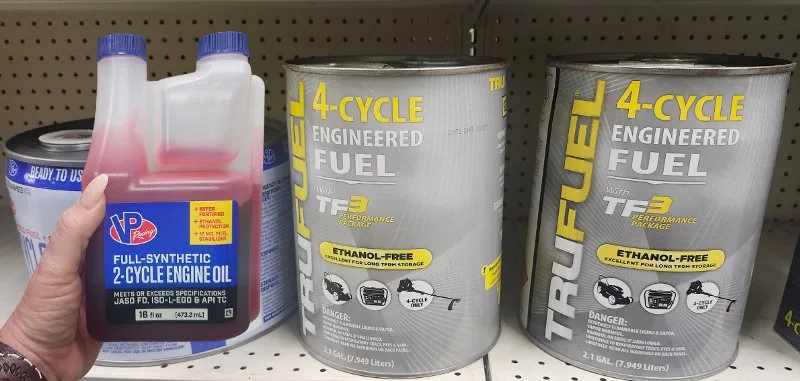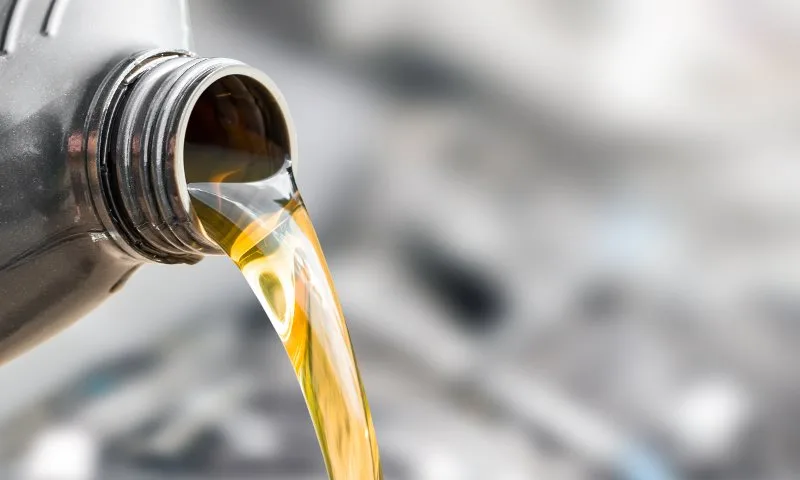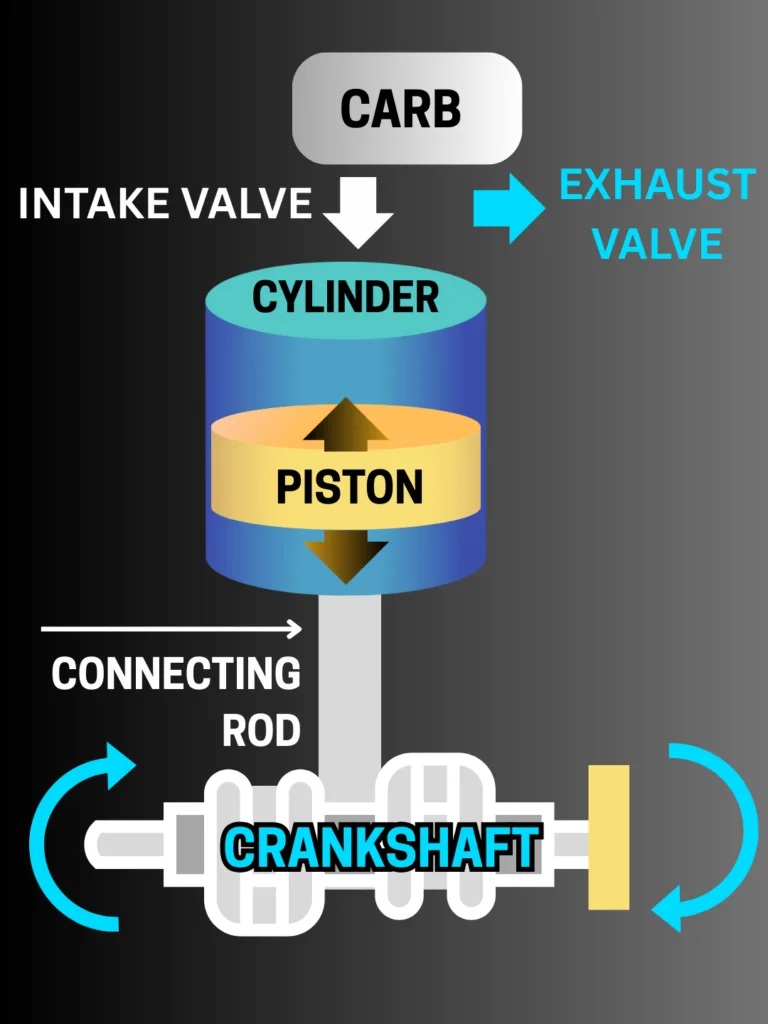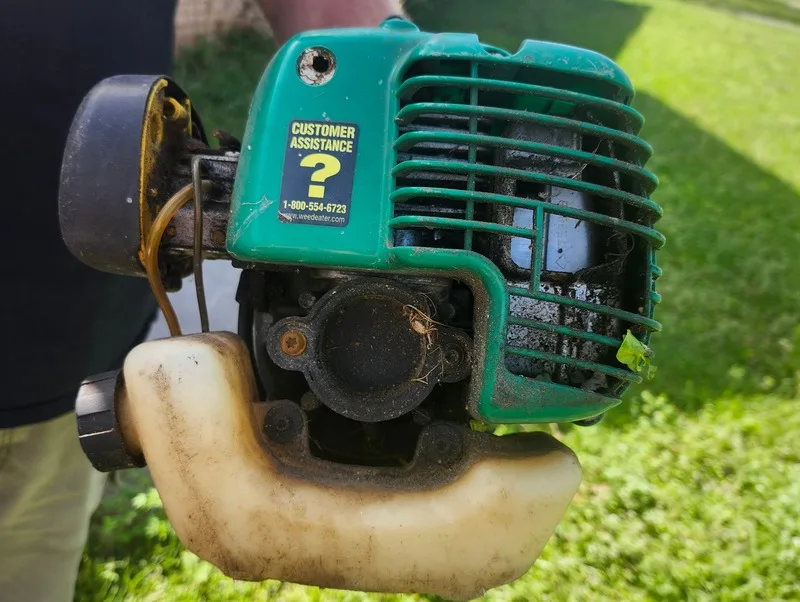Strokes/cycles are the number of phases a piston takes to travel across its cylinder. When evaluating 2-stroke vs. 4-stroke engines, 2-strokes are faster and lighter. However, 4-stroke engines have better strength and endurance.
After years of testing and reviewing power tools, I teamed up with engine expert Jeff Yochum to explain the differences between 2-stroke and 4-stroke engines. We focus on what matters most when purchasing a power tool or dirt bike. Use our handy head-to-head comparison chart as a cheat sheet.
2-stroke vs. 4-stroke engine:
2-Stroke Vs. 4-Stroke Engines: Which is better?
| 2-stroke | 4-stroke | |
| Fuel | ✘ | ★ |
| CO2 | ✘ | ★ |
| Speed | ★ | ✘ |
| Durability | ✘ | ★ |
| Upkeep | ★ | ✘ |
| Weight | ★ | ✘ |
| Noise | ✘ | ★ |
| VE | ★ | ✘ |
| Torque | ✘ | ★ |
Fueling 2-Stroke Vs. 4-Stroke Engines

Fueling: 4-Stroke
CO2: 4-Stroke
Four-stroke engines run on ethanol-free gas, while 2-cycle engines run on a gas-oil mixture. “Follow the gas-oil ratio recommended in the user’s manual,” advises Yochum. “Doing so will maximize a two-stroke engine’s performance and lifespan. It will also prevent unintended damage.”
Four-cycle engines are more fuel efficient than 2-cycle engines because pure gas burns cleaner and faster than a gas-oil mix. By burning both gas and oil, 2-stroke engines expel heavier carbon emissions.
Oil Changes & Maintenance

Upkeep: 2-stroke
Four-stroke engines need oil changes, but 2-strokes don’t. However, 2-stroke engines need their spark plugs replaced a little bit more frequently. Still, 2-stroke engines are the lower maintenance option.
Engine Speed of 2-Stroke Vs. 4-Stroke Engines

Speed: 2-Stroke
Two-stroke engines are faster because they’re smaller and lighter. Additionally, they rotate the crankshaft with fewer strokes. Crankshaft revolutions per minute (RPM) is the main measure of engine speed.
When buying lawn care tools, it’s pays to keep a keen eye on speed, as Yochum explains:
“Engine speed is essential in equipment, such as string trimmers and blowers, because it takes engine speed (RPM) to generate your desired effect. I.e., the amount of blow force coming out of a blower or the high speed of the string used to trim weeds.”
Engine Power

Torque: 4-Stroke
VE: 2-Stroke
The primary measure of engine power is horsepower (hp), and engine displacement (cc) indicates the amount of power an engine can produce.
Horsepower (hp)
Horsepower measures the power an engine produces, using the formula below.
hp = Torque ✕ RPM ÷ 5,252
Four-stroke engines have better torque than 2-strokes, as Yochum explains:
Two-strokes take a lot higher RPM to produce the same amount of power as a four-stroke.
Engine Displacement (cc)
Whereas horsepower measures actual power, engine displacement measures an engine’s potential to produce power. It’s the volume of an engine’s cylinders, measured in cubic centimeters (cc). Thus, engines with higher displacement have more air moving through them.
Two-cycle engines have greater volumetric efficiency (VE). That means they need less displacement to have the same power potential as a four-stroke engine. For example, a 250-cc 2-cycle dirt bike is as potent as a 450-cc 4-cycle bike.
Understanding Engine Strokes

Strokes are the number of cycles it takes a piston to move across its cylinder. Hence, a 2-stroke engine is also called a 2-cycle engine.
Pistons are disks that move up and down inside cylinders. They generate vertical energy that the connecting rod transfers to the crankshaft. Then, the crankshaft converts that vertical force into rotational movement.
2-stroke pistons travel across their cylinder in 2 phases:
- Upstroke: The piston moves up, compressing and ignited fuel/-air
- Downstroke: The piston moves down, expelling exhaust.
4-stroke pistons travel across their cylinder in 4 phases:
- Exhaust: The piston comes up, expelling exhaust out the exhaust valve.
- Intake: Fuel enters through the intake valve.
- Compression: The piston moves up, causing compression.
- Ignition: Fuel is ignited, generating engine power and forcing the piston down.
2-Stroke Vs. 4-Stroke Engine Life

Lifespan: 4-Stroke
Four-cycle engines are more durable because they have a separate oil system (like a car). Hence, the engine’s moving parts get better lubrication.
Also, 2-stroke engines run hotter. Exposed to extreme heat, the engine’s metal components fatigue. Eventually, the heat causes permanent damage.
Operational Comfort

Weight: 2-Stroke
Vibration: 4-Stroke
Noise: 4-Stroke
All else equal, two-stroke engines are lighter because they have a lower weight-to-power ratio. Thus, it’s less strenuous to maneuver tools with a 2-stroke engine.
However, while rapidly rotating, 2-cycle engines vigorously vibrate. In addition to being uncomfortable, their heavy vibration makes an annoying high-pitched sound.
2-Stroke Vs. 4-Stroke Engine FAQ
Will a gas/oil fuel mix damage a 4-stroke engine?
“A gas-oil fuel mix won’t cause permanent damage, but it will make a 4-stroke engine smoke. If you run a lot of the gas/oil through the engine, it may need new spark plugs,” explains Yochum.
What’s better, a 2-stroke or 4-stroke leaf blower?
It depends on whether it’s a handheld vs. backpack leaf blower:
- Since 2-stroke engines pack more power in a lighter package, they work best in handheld leaf blowers.
- A 4-stroke backpack leaf blower is more durable and better on fuel, but a 2-stroke is lighter.
What’s better, a 2-stroke or 4-stroke string trimmer?
Most of the top gas-powered string trimmers run on a 2-stroke engine, but some good models have a 4-stroke engine. However, 2-stroke string trimmers cost less and are lighter weight.
What’s better, a 2-stroke or 4-stroke dirt bike?
It depends on preference. Both 2-stroke and 4-stroke dirt bikes have advantages and pitfalls, as shown in the table below.
| 2-stroke dirt bikes | 4-stroke dirt bikes |
|---|---|
| ☆ Power up quicker ☆ Take off quicker ☆ Lower maintenance | ☆ Longer lifespan ☆ More fuel efficient ☆ Better traction ☆ Better endurance |
Buying the Best Power Tools
Howdy, I’m Daisy Damsky. I started Daisy Outdoors to help homeowners become savvy power tool shoppers. To help me keep my content ad-free, please buy me a coffee.
